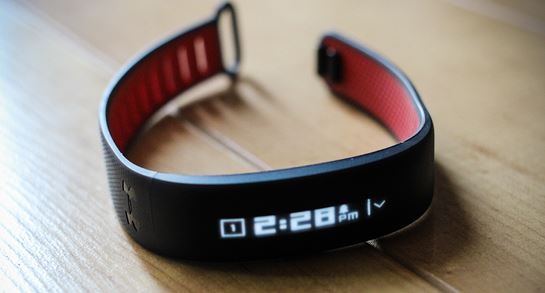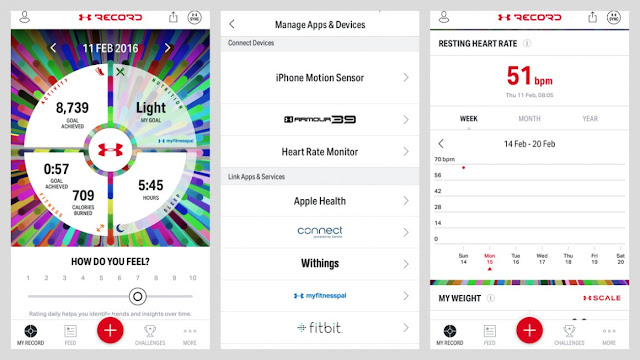The Under Armour Band is the HTC Grip reborn. The US sports giant's first wearable was delayed from launch in 2015. But now it's back with a new look.
You can pick up the Band for $180, making it a more expensive purchase than the Fitbit Charge HR and our current fitness tracker fave, the Jawbone UP2. The Band will count steps, measure resting heart rate and deliver notifications from your phone. So far, it doesn't sound all that different from what you can already get your hands on.
What's special, for now, is that it also forms part of a newUA HealthBox platform, which includes a heart rate monitor chest strap, a smart scale and a pair of smart running shoes. The idea is that all the products will play nice with each other and pull all of your data into the UA Record app, delivering more more detailed insights into your health.
So was it worth the wait? Here's our verdict on HTC's and Under Armour's debut fitness tracker.
Under Armour Band: Design
Straight out of the box the Band has a simple, inoffensive charm about it. It's the Grip evolved but there are some clear changes here. Some good, some not so good. The clasp is now a more simple setup, as Under Armour and HTC decided to ditch the Nike Fuelband-style charging connector and clasp in one.
The smooth finish on the band has gone too, replaced with an attractive textured finish that feels more in keeping with rival sportier-looking fitness trackers. It's water resistant up to two metres, but before any swimmers get excited, we'll warn you that the UA Band isn't designed to be used in the pool.
There's a clear nod to the union of the two companies with the HTC logo located on the clasp and the Under Armour red button that simply turns the screen on and off. On the whole, it's a minimalist approach and one of the nicer of the plain-looking trackers I've had around my wrist. It's comfortable and sits securely too.
Open it out and you'll find a brighter red underside where the textured finish continues. This is where you'll find a small optical heart rate sensor and a set of gold charging pins, which signals another proprietary charging cradle to add to the collection. This is by far one of the worst though. It magnetically connects but the connection is so weak that if you don't carefully place it somewhere it's going to come loose.
That however is not the most disappointing aspect of the Band. That's reserved for the sub-par screen. It's a 1.3-inch POLED touchscreen display – although this appears as a mere sliver on the band – so it's the same as the one on the Grip. It's eaten up by the massive bezel surrounding it, making it a tiny display to look at.
The low resolution makes the screen's appearance murky and despite having three brightness levels, we found it difficult to quickly view progress in bright light and at night. It's a bit like the first generation Garmin Vivosmart tracker, but worse. On a positive note, it's nice and responsive when you swipe your fingers across. It's just a shame Under Armour and HTC didn't go with something more vibrant and cutting edge.
Under Armour Band: The app
The Under Armour Record app is the standout feature of the Band. If Under Armour and HTC decide to make another wearable (which I'm sure they will) then they'll have the software foundations to rival the Fitbits and the Jawbones of this world.
It's available on Android and iOS and there's plenty of third party app and device support. Head into the Manage App & Devices section of the app and you'll see a list that includes Jawbone, Fitbit, Misfit, Polar, Suunto and more. That's not forgetting that Under Armour now owns Endomondo, MapMyFitness and MyFitnessPal, the latter of which is deeply integrated into the Record app.
The idea is that all of the data can be shared between several apps with the Record app acting as the hub. I wouldn't say it works perfectly right now, but with some work, there's the makings of a great app here.
Day-to-day use is pretty straightforward too. At the heart is a big circle broken down into four quadrants. These represent activity, nutrition, fitness and sleep: the cornerstones of a healthy life. according to Under Armour. The nutrition section is powered by MyFitnessPal giving you the option for a more simplified breakdown of your calorie consumption or to download the MyFitnessPal app to be more precise about your intake.
Below that you've got a "How do you feel?" numbered scale, which supposedly filters into daily data insights and identifying trends. Then you can scroll down to see progress towards goals, resting heart rate data and weight data, if you've got the UA Scale synced.
There's a Facebook-style feed to see activity history and a challenges section to take on fellow Under Armour pals. Up top you will find shortcuts to your profile and the ability to share data via email, Twitter and plenty of other places. The Sync button will take you into a list of your supported devices. In the UA Band section, this is where you can set up preferences like turning on auto sleep tracking, setting up phone notifications and using the phone's GPS to track routes.
One aspect you should see pop up from time to time are the insights based on your logged data. This is powered by IBM Watson, which is basically similar in the end result to Jawbone's Smart Coach or Microsoft Health for the Band 2. It analyses data and makes suggestions on aspects like sleep or physical activity in comparison to similar aged users.
I didn't find the insights quite as useful as those offered by Jawbone, but Under Armour plans to improve this aspect by adding metrics such as weather and temperature insights to suggest ideal conditions for training outside. It's good to see some form of actionable data happening here and it's a solid starting point.
Overall, I got on well with the Record app. There definitely needs to be some work on how the data from different apps feeds into this central hub, but I've seen enough to say that Under Armour is onto something good here.
Under Armour Band: Tracking
In terms of 24/7 activity tracking the UA Band largely covers the basics. It'll count steps and measure distance, but there's no altimeter so you can't track elevation. Sleep monitoring is automatic (once you've turned this on in the app) and accelerometer based, so you're going to get as detailed tracking as a Fitbit Charge HR or a Jawbone UP3. You can also set up inactivity alarms, which will push out a message on the Band's screen when you haven't been moving for the past hour.
I put it up against the Jawbone UP2 for step tracking and sleep monitoring and as the screenshots below illustrate, it delivered identical readings, which is encouraging. I will say though that the sleep tracking can be very temperamental. On several occasions it hadn't saved to the app or I'd woken up and accidentally paused or stopped the tracking.
Step tracking compared: UA Band (left) and Jawbone UP2 (right)
There's an optical heart rate monitor here but it's focused on measuring resting heart rate to help provide a more comprehensive record of your daily health. As a general rule 60-100bpm is good, any higher is not. I took a few on the spot heart readings against the TomTom Spark running watch and a Polar H7 heart rate monitor strap running through Polar Beat, and found the Band delivered some excessively high readings. At times there was a 20-30 bpm difference. That's huge.
Sleep tracking compared: UA Band (left) and Jawbone UP2 (right)
The heart rate monitor is not built for high intensity training, something that HTC's design boss explained to us in great detail, and this is a big reason why Under Armour also launched a heart rate monitor chest strap, to serve those who want to get serious.
I took the Band out for a few runs using the TomTom Spark and Under Armour's new chest strap. The external monitor is supposed to pair with the Band to deliver heart rate readings, but I simply never got it to work. That wasn't the biggest issue though. Midway during a couple of runs, I noticed that the Band had paused itself underneath my running jacket, so half of my session didn't get tracked.
In fitness mode you can log runs, cycling sessions, gym workouts and long walks, however, there's no GPS built into the band despite it having been included on the HTC Grip. Instead the Band relies on the accelerometer to measure distance, but you can choose to use your phone's GPS to track routes if you want. Based on my previous experience with trackers that use an accelerometer to track distance, I didn't have high hopes.
Distance tracking compared: UA Band (left), TomTom Spark (centre) and Runkeeper iOS (right)
When I did eventually get a full run without pausing, the UA Band was generally 400-500 metres short compared to the TomTom Spark and Runkeeper iPhone app. In other words, GPS is still king when it comes to accurately tracking distances.
If you're only going to use the Band for baseline activity tracking, then it's fine. But when it comes hardcore gym sessions or running, it's just not equipped for that yet.
Under Armour Band: Notifications
Fitness trackers are no longer just fitness trackers and that means playing a little nicer with your phone. We're talking about notifications; the kind that will stop you reaching into your pocket for your handset.
Under Armour's approach to letting you know when you have an appointment coming up or a text message waiting to be read is pretty basic. You need to customise it in the settings on the UA Record app first to decide what you'll see on the Band.
Once it's set up, there's very little delay between your phone registering something and seeing the notification pop up on that slither of an OLED screen. On the clock screen, a little box signifies that you've got notifications backed up. The screen is too small to ever show a notification in full so a swipe is required. You can snooze notifications and close them all down completely if you want.
Away from notifications, the Band does also have a dedicated calendar section and the ability to set up alarms. There's also a set of music controls, however I found to my disappointment that it doesn't appear to play nice with third party music apps like Spotify, opting to launch native music applications instead.
Under Armour Band: Battery life
In terms of battery life the UA doesn't break new ground. You can expect up to five days, but that can depend on a whole host of things. If you've got the screen brightness cranked up to the max or a full stream of notifications, it'll be less. Using the exercise tracking feature can also dent battery performance and that's exactly what I found.
I managed to get four days out of the Band, tracking a couple of runs and with full notifications switched on. After a full charge, which only takes about 30 minutes, I found myself charging again after about two and half days. But if you're willing to scale back on your use of some of the features, you can get five days.



